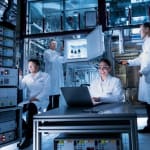
Climate protection is firmly embedded in BASF’s new corporate strategy. A central goal of this strategy is to achieve CO2-neutral growth until 2030. To accomplish this, BASF is continuously optimizing existing processes, gradually replacing fossil fuels with renewable energy sources and developing radically new low-emission production processes. The company is bundling all of this work in an ambitious Carbon Management program. Today, BASF presents the latest research findings on these new processes as well as innovative, climate-friendly products at its Research Press Conference in Ludwigshafen.
“To reach the climate protection targets, a large-scale reduction in CO2 emissions will be necessary. As a raw material, CO2 is only suitable in selected applications and such uses will therefore not make a decisive contribution to slowing climate change,” stressed Dr. Martin Brudermüller, Chairman of the Board of Executive Directors and Chief Technology Officer of BASF SE. In the past decades, the company has already avoided considerable CO2 emissions by optimizing its production processes and increasing efficiency. Since 1990, BASF has reduced its greenhouse gas emissions by 50% while doubling its production volumes in the same period. “Achieving another significant reduction in CO2 emissions will require entirely new technologies, which is why BASF has launched an ambitious R&D program,” said Brudermüller.
Because energy is needed to perform chemical reactions, fossil fuels are the largest source of CO2 in the chemical industry. BASF’s steam crackers, for example, must reach a temperature of 850°C in order to break down naphtha into olefins and aromatics for further processing. If this energy could come from renewable electricity instead of the natural gas typically used now, CO2 emissions could be dramatically reduced by as much as 90%. BASF therefore aims to develop the world’s first electrical heating concept for steam crackers within the next five years. At the same time, material testing will be necessary to determine which metallic materials can withstand the high electrical currents and are suitable for use in this type of high-temperature reactor.
The production of hydrogen also releases significant volumes of CO2. The chemical industry uses large quantities of hydrogen as a reactant. At BASF, for instance, it is used in ammonia synthesis. Hydrogen will also be essential for many sustainable energy carrier and energy storage applications in the future. Together with cooperation partners, BASF is therefore developing a new process technology to produce hydrogen from natural gas. This technology splits natural gas directly into its components hydrogen and carbon. The resulting solid carbon can potentially be used in steel or aluminum production, for example. This methane pyrolysis process requires comparatively little energy. If this energy comes from renewable sources, hydrogen can be produced on an industrial scale without CO2 emissions.
Development of new catalysts is vital to success
As a central, high-volume intermediate, olefins represent an especially important area where BASF is looking to develop new low-emission processes. The considerable CO2 emissions resulting from current production methods in the steam cracker could also be significantly reduced through “dry reforming” of methane. This process creates a syngas which is then transformed into olefins via an intermediate step of dimethyl ether. BASF researchers have now been able to find a way to do this for the first time thanks to new, high-performance catalyst systems. These new-generation catalysts are being marketed in cooperation with Linde. Depending on the availability of raw materials and renewable electricity, this innovative process could then be a complement or alternative to the potential electrical heating of steam crackers.



